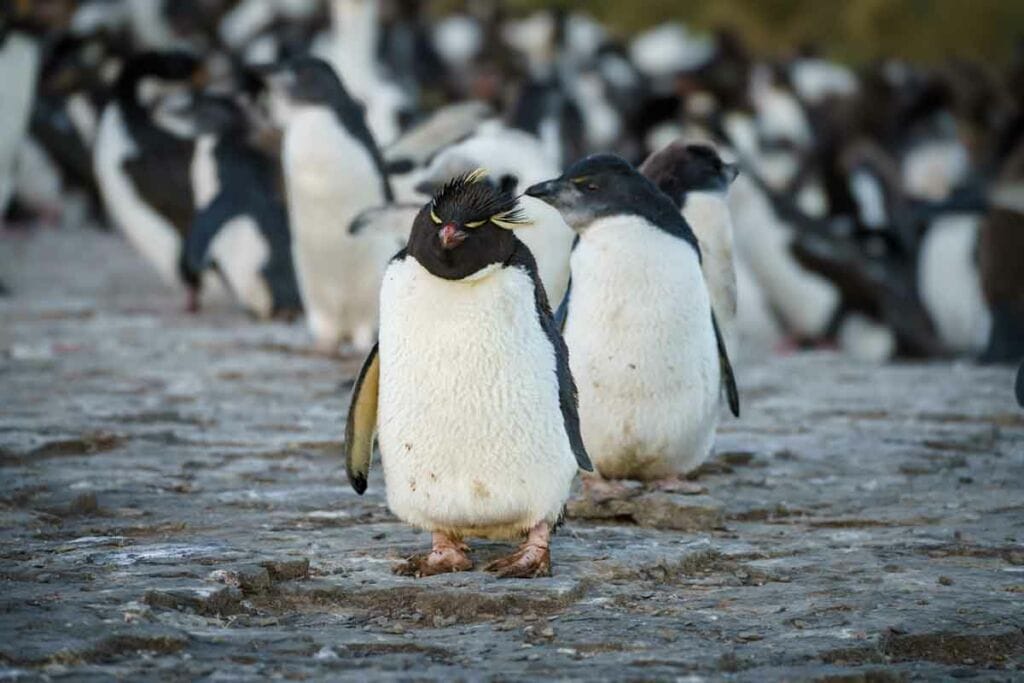Are you having a hard time to choose what islands to visit in the Falklands? Well, Bleaker Island should definitely be one of them – and here we’ll tell you why!
I loved every single day of my week in the Falklands, but the time I spent on Bleaker Island was probably my favourite. I was very lucky with the weather – I guess the radiant sunshine and beautiful light had something to do with why I loved it so much, but trust me, it’s a very special place.
Talking with seasoned Falkland travellers, I learned that every island in the archipelago offers something special. For example, Carcass is known for its hilly vistas, Sea Lion because it’s compact yet full of wildlife, Saunders for the unique “penguin shower” – so, what is Bleaker’s claim to fame?
If you ask me, Bleaker is special for two reasons. First, the wonderful lodge, great food and warm welcome – travelling around the Falklands, food can sometimes be hit and miss, and accommodation can be a little basic. On Bleaker, hospitality is truly excellent.
Second, Bleaker is really stunning in terms of landscapes, even though there are no hills. And naturally, there’s plenty of wildlife anywhere you go. Imagine watching the sunset from a white sandy beach, while Gentoo penguins surf the waves right in front of you. Or having breakfast sitting on a clifftop, surrounded by Rockhopper penguins, and no other humans.
These are just a couple of reasons why I loved Bleaker Island so much – now you just need to see it for yourself!
Where is Bleaker Island
Bleaker Island is located just off the southwestern coast of East Falkland, about half an hour flight from Stanley, and just 10 minutes from Sea Lion Island.
Bleaker Island measures a total of 2070 hectares, and 20 km from one side to the other. It is long and thin, with lots of inlets and coves, with a shape reminiscent of a crescent.
Why is Bleaker Island Special
Due to its shape, Bleaker was originally known as Long Island, and then became known as Breaker Island after the strong waves that regularly crash on its shores. Since 1857, the name was changed to “Bleaker” on maps and charts, but the reason is not really known.
The island has housed a sheep farm for over 100 years, and there is still an organic farm, with sheep and cattle coexisting peacefully with local wildlife. It’s the ideal island to experience the best of both worlds, getting a taste of Falklands farming lifestyle while admiring penguins, sea lions and other birds.
As mentioned before, the island is long and thin with a varied coastline, including cliffs, rocky coves, sheltered bays and wide sandy beaches. Speaking of the latter, the best known (and most easily accessible) is definitely the aptly-named Sandy Beach, located just northeast of the landing strip.
Penguins are definitely plentiful around the island, but there’s plenty of other bird life to see – crested caracaras, brown skuas, ruddy-headed geese and the endemic Falkland steamer ducks are just some examples. There’s also a vast Imperial cormorant colony not far from the lodge.
In terms of mammals, Bleaker is a good place to see sea lions, Peale’s dolphins and sei whales, frequently spotted in late summer and autumn. Botanists should also keep a look out for lady’s slippers, an endemic flower species, as well as yellow and dog orchids.
I didn’t have time to visit the southwestern half of Bleaker, but I was told there are some scenic hikes and it’s a good place to watch sea birds nest on the rocky cliffs.
Best Time to Visit Bleaker Island
Just like with the rest of the Falklands, the best time to visit Bleaker Island is between October and April. The spring/summer season offers longer daylight hours, fewer chances of wind and rain, and warmer temperatures – about 12/15°C during the day, rising to about 20 on warm sunny days.
Different months offer different wildlife experiences – November/December is breeding season for both penguins and sea lions, January/February are the best months in terms of weather and also good times to see fluffy penguin chicks, and March is prime whale watching time.
How to Get to Bleaker Island
Unless you are travelling on a cruise ship calling at Bleaker Island, the only way to get there is by FIGAS flight.
FIGAS is short for Falkland Islands Government Air Services, and operates Islander planes that connect Stanley with smaller islands. Bleaker Island has a short runway, so planes can only take 7 passengers. Flight time from Stanley is about 30 minutes, but planes operate as a “flying taxi” service and often call at other islands before reaching Bleaker.
Fares are approximately £185 return for visitors with a 20 kilo luggage allowance. Please be sure to reserve your flight ahead of time by contacting FIGAS or a Falkland-based travel agent.
To learn more about FIGAS and how to plan your trip, here’s our How to Visit the Falklands guide!
What to Do on Bleaker Island
We recommend staying at least two or three nights on Bleaker Island to explore the island without having to rush around. You can download the official conservation leaflet here to have a look at what to expect.
Here’s a quick rundown of my favourite spots!
-Sandy Beach
Sandy Beach is located about 200 m northeast of the landing strip, and its name is pretty self-explanatory – a wide arch of fine white sand looking onto the deep-blue ocean. A little islet named Ghost Island lays off the shore, and the small Penguin Hill is just north of the beach.
The beach is home to a numerous Gentoo colony, and at the time of my visit I also saw some King penguins. It’s a very beautiful sunset spot, even though the sun sets behind the beach, and a great location to photograph wildlife at golden hour.
Just off the beach you’ll see several Magellanic penguins in their burrows. My visit was in late January and I also saw some skua chicks in ground nests – keep a look out for them if you’re planning to visit then.
-Rockhopper Penguins
From Sandy Beach, you can easily follow a vehicle trail heading to the settlement, about 2.5 km away. First you’ll pass Big and Small Pond, two great location to see waterfowl like steamer ducks, white-tufted grebes and naturally the ubiquitous upland and ruddy-headed geese.
Keep walking for about 45 minutes until you reach a fence with a sign saying “Rockhoppers”. Open the gate, walk in and follow the rocks along the path snaking through the tussac grass to reach my favourite place in the whole of the Falklands.
Bleaker’s Rockhopper penguin colony is atop a cliff, and if you visit and observe them for a while, you’ll see them dive in and out of the water, and do their signature “hop” to move across the rocks.
You’ll notice that there are many Imperial cormorants living alongside Rockhopper penguins in the same colony – this phenomenon is common on remote island like Bleaker, where low availability of nesting areas and protection from external predators often creates mixed colonies. If you are interested in the topic, this open-access academic paper provides a great overview.
Keep your eyes open for Macaroni penguins (look for their slick orange brows) and Northern Rockhoppers (with longer and fluffier yellow brows), usually found on Subantarctic islands near New Zealand.
-Imperial Cormorants
Another site you definitely won’t miss is the massive Imperial cormorant colony, about 300 m away from the lodge. This colony is home to approximately 8000 breeding pairs, and it looks really impressive, especially just before nightfall when most birds have returned to their roost.
-Sea Lions
Just south of the lodge you can visit a sea lion colony. You can view the sea lions from the top of a cliff, and they usually lay on the beach or the rocks below.
There are sea lion colonies in other islands around the Falklands – I also saw them on Sea Lion Island (naturally), but the Bleaker sea lions were a lot closer and easier to photograph.
How to Get Around Bleaker Island
From the settlement, where the lodge is located, you can easily visit all the locations mentioned above on foot. Jeep tours around the island are also on offer, which are indeed recommended to get oriented before exploring more on your own.
The lodge owners can also arrange drop offs in various locations around the island, useful if you want to hike around the southwestern part of the island. It is also possible to rent 4×4 vehicles for about £50 a day.
Where to Stay on Bleaker Island
Bleaker Island is privately owned – the same family owns and runs both the farm and the lodge. Accommodation is in two separate buildings, located one across the other about half way down the island in the place marked on maps as “Settlement”.
The lodge is the best place I stayed at in the Falklands so I really recommend booking in advance and adding Bleaker to your Falklands itinerary!
-Accommodation
You have two choices on where to stay – Cassard House, named after a nearby wreck, and Cobb’s Cottage, taking its name from the first farmer on Bleaker.
Cassard House sleeps eight in three twin and one double bedroom, all with ensuite bathrooms. Common spaces include a lounge with a table where communal meals are served, and there’s also a spacious sunroom with books and a honesty bar.
Cobb’s Cottage has two ensuite bedrooms, a lounge and kitchen. It’s ideal for families and groups travelling together, and for those who want to self-cater.
Would you like to know why these islands are so special? Here are 15 Curious Facts about the Falklands!
-Food and Drinks
Guests can choose between self-catering (£109 per person/night in 2025), or a full board stay (£199). Self-catering sounds convenient, but remember you’ll have to carry your own food from Stanley, as there are no shops on Bleaker – and you only get limited luggage allowance on FIGAS.
We recommend going for full board as the quality of food on Bleaker is really excellent. You start your day with a full English breakfast at 8.30 AM, followed by a packed lunch with a sandwich, crisps, chocolate and a piece of fruit – you can place your orders for lunch and breakfast the previous night.
At 6.30 PM you’ll be served an excellent three-course dinner, and the menu changes daily. Dietary requirements are catered for but please remember to communicate them in advance, as all groceries need to be shipped from Stanley.
Just like all other Falklands lodges, you’ll also find a self-service tea and coffee corner with flasks in case you want to take a hot drink with you while sightseeing, as well as a honesty bar with Falklands beer and gin as well as South American wines.
I was a guest of the Falkland Islands Tourism Board during my week in the archipelago. I would like to thank Sasha for her help and support, and Japa from Blogilicious for having me! I had a wonderful time and would return in a heartbeat.











Fantastic write-up, Margherita. I’ve been to Bleaker Island twice, and I completely agree — the Rockhopper colony is unmatched in accessibility and drama. One thing I’d add: the mixed colonies of penguins and cormorants are not just beautiful but scientifically fascinating — especially how they adapt to limited nesting space. Also, for anyone going: bring binoculars. Spotting sei whales from the cliffs is unforgettable, but easy to miss without them. Thanks for putting Bleaker back on the radar — way too overlooked compared to Sea Lion or Saunders.
Thank you Alex! I only spent one day on Bleaker but I loved it, and I’m hoping to visit again one day!